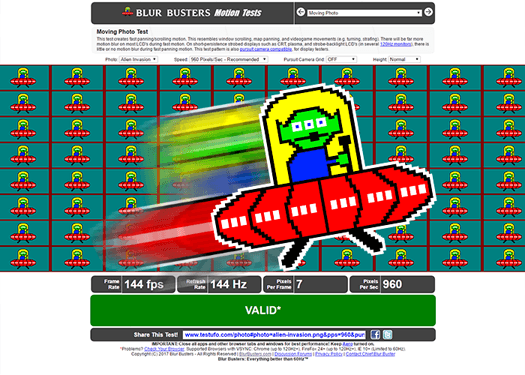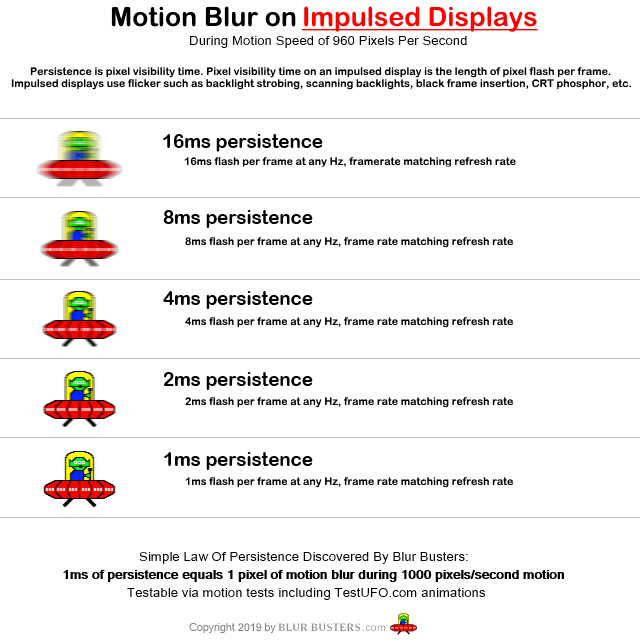The Test UFO Motion Tests at TestUFO.com is the world’s most popular display motion test, created by Blur Busters founder Mark Rejhon. It is frequently used to test monitors and other screens.
UPDATE 2021: A Samsung Research Paper at SID cites this article! If you don’t have a SID membership, you can confirm my citation by doing a Blur Busters / TestUFO name search at Google Scholar.
UPDATE 2025: We now recommend doubling motion speed of 1920 pixels/second to compare 240+ Hz screens. You ideally motion speeds in pixels/sec at least 4x refresh rate to tell apart sample-and-hold displays. We have made minor edits to this article to accommodate this updated information.
It contains dozens of tests including explanatory science (eye tracking, persistence of vision, black frames, variable refresh) and tests designed for display analysis (pursuit camera test, scanout test), and many others selectable tests.
What’s very special about TestUFO? It uses a default motion speed of 960 pixels per second.
960 Pixels/Sec Is Closest Number To 1000 Divisible By 60, 120 and 240 Hz
There was a need for a motion speed divisible by futuristic refresh rates long before they came on the market. TestUFO launched in 2013, well before the first 240Hz monitors and the 480Hz experimental display! We wanted to use something that easily compares math to pictures, and pictures to math.
1ms translates to 1 pixel per 1000 pixels/second — the simplified Blur Busters Law formula.
960 Pixels/Sec Is Faster Than Many Outdated TV Benchmarks
A very old, formerly common motion resolution benchmark for televisions, monitors and displays was a test pattern used by plasma television manufacturers, FPD Benchmark Software (Blu-Ray Chapter 31). As I used to work in the home theater industry, old television engineers and old home theater magazines were using outdated “lines of motion resolution” methods that often varied with motion speed. Flaws of FPD are explained here.
To avoid this outdated test, TestUFO needed to come up with universal motion benchmarking that stayed consistent regardless of motion speed in the retina resolution race (4K, 8K+) and retina refresh rate race (120Hz, 240Hz+).
960 Pixels/Sec Is More Representative Of Fast Video Game Motion Speeds
Old benchmarks for televisions used very slow scrolling test patterns. Sports & gaming use faster motion than these benchmarks. Motion in esports competitive games such as Fortnite, Counterstrike: GO, and other games can go thousands of pixels per second, creating a massive amount of display motion blur.
960 Pixels/Sec Is Not Too Fast To Eye-Track
The speed of 960 pixels per second means an object takes 2 seconds to cross a 1920×1080 display. We needed a fast motion speed that was still possible to eye-track. We are very familiar with eye-tracking motion blur which is an important component of the science of display motion blur,
First, look at the stationary UFO, then look at the moving UFO. On most LCD and OLED displays, you are witnessing eye-tracking-based motion blur with the moving UFO. This is blurring from persistence (MPRT).
960 Pixels/Sec Is Easy To Double And Quadruple
The tidy 960 number is also very easy to memorize for testing faster motion speeds.
- 960 times 2 equals 1920, the horizontal resolution of 1080p displays.
- 960 times 4 equals 3840, the horizontal resolution of 4K displays.
- 960 times 8 equals 7680, the horizontal resolution of 8K displays.
Our UFO Trademark Is A Deliberate Test Pattern Easter Egg!
Did you know that our Blur Busters UFO logo was intentionally designed as a test pattern?
- At 16 pixels of motion blur, UFO landing legs are very blurry.
- At 8 pixels of motion blur, UFO landing legs are seen but saucer details are very blurry.
- At 4 pixels of motion blur, UFO saucer details are seen but can’t count alien eyes.
- At 2 pixels of motion blur, UFO alien 3 eyes can be counted but are still blurry.
- At 1 pixel of motion blur, UFO alien 3 eyes have clear eye pupils & eye whites.
Here is a handy comparison chart of motion blur at 960 pixels per second, used in many of our articles such as 60Hz vs 120Hz vs ULMB, as well as Amazing Journey To Future 1000Hz Monitors.
Note: These images assumes insignificant GtG pixel response that is only a tiny percentage of a refresh cycle. See Pixel Response FAQ: GtG versus MPRT for more information how pixel response can degrade motion blur further.
960 Pixels/Sec Bridges Popular Science & Advanced Research
We understand display manufacturers have to use photodiode oscilloscopes and other complex measuring equipment, and to use VESA measurement standards that accommodates noise margins. However, many people need something easy to explain in images and video as a bridge between familiarity (looking at pictures) and what researchers and scientists do (using measuring equipment).
1ms of persistence = 1 pixel of motion blur per 1000 pixels/second.
Conclusion: 960 Pixels/Sec is a Universal Display Motion Test Speed
Or a multiple thereof, such as 1920 pixels/sec.
Faster Motion Speeds For Higher-Hz Displays Is Still Recommended
To distinguish the highest refresh rate displays, it is necessary to have a motion speed at least 4x the display refresh rate. Therefore, comparing displays near or above 480 Hz, you ideally want to test 1920 pixels/sec.
This is the motion speed nearest 2000 pixel/sec that is divisible by common refresh rates. Sample and hold displays can become indistinguishable at high refresh rates with slow motion. This requires increasing motion speeds when testing higher refresh rates.
This is because, on a perfect sample and hold display (0.000ms square wave GtG), persistence motion blur (eye tracking & camera tracking) is exactly equal to the pixel step between frames. You need a sufficiently large step (e.g. 4 pixels) between frames, to distinguish extremely high refresh rates on sample and hold displays.
Fortunately, higher resolutions (4K vs 1080p) now make it easier to increase motion speeds without increasing camera speeds too much. However, some point, motion speeds get too fast for human eyes to track, which determines the retina refresh rate of no further humankind benefit.
Today, 1920 pixels/sec is a comfortable medium-speed pan (or scroll or mouselook) on a 4K display, so this is a realistic display testing motion speed today. From this, we tweaked test cases that allowed most humans to see 120fps vs 480fps OLED more clearly than 60fps vs 120fps during a custom test case involving 1920 pixels/sec panning motion of blur-free source material. This outlines the importance of increasing motion speeds.
See vicious cycle effect and scientific test case variables where higher resolutions amplifies refresh rate limitations. In addition to geometric comparisions (e.g. comparing large refresh rate multiples), these are the scientific variables that helps determine a theoretical perfect sample-and-hold display that have no motion blur at the fastest human eye tracking speeds.
Industry Standard Motion Blur Testing
Test UFO Motion Tests paved the industry standard display motion speed. Many researchers, companies, reviewers now use variants of this motion speed, thanks to TestUFO being used by millions of visitors worldwide. Our most popular display test is TestUFO Motion Blur / Ghosting / Pursuit Camera test.
The industry has now utilized multiples of 960 pixels/second as the standardized motion speed, whether they use TestUFO or their internal test — including RTINGS, NVIDIA, and many dozens others!










